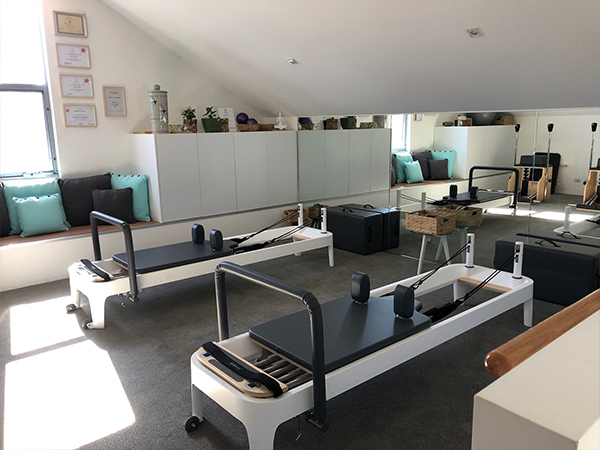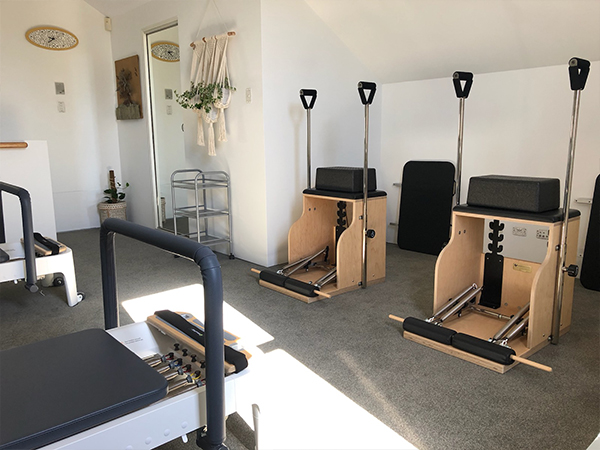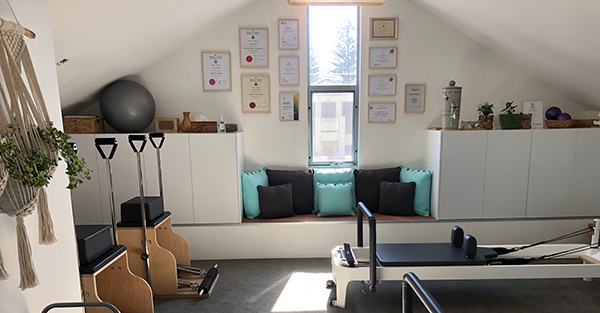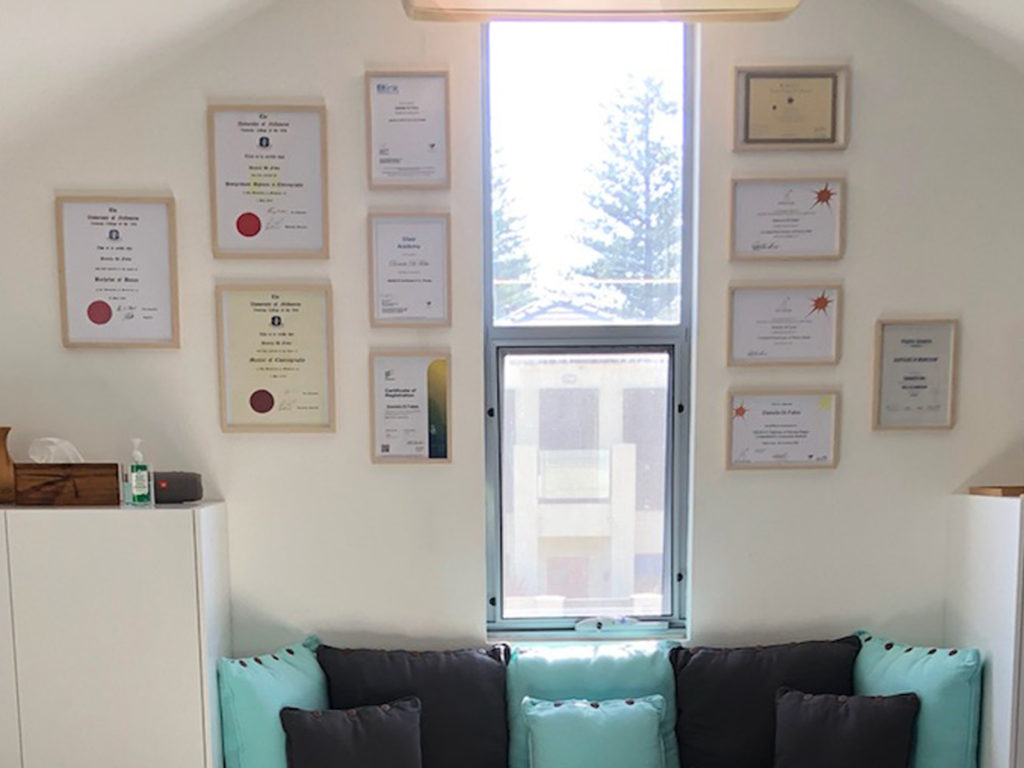
In early 2021 I decided to embark on a new venture: setting up a small home-based Pilates studio. It is now one year on and finally up and (almost) running.
This article seeks to share my journey with you by covering some key points that may assist those of you who are also considering ‘starting small’.
Idea
I had been mulling over opening a Pilates studio for a year or two. To my despair, when I did the math it was clear that my budget would not allow for it. I would need a commercial lease, business insurance, six or seven pieces of equipment, small apparatus, studio fittings, furnishings and my own clients (none of which I had). In addition, I would need to generate income by continuing to work for others until my business grew; without a substantial ‘Pilates Fund’ set aside, I was limited.
Unfortunately, my passion-fuelled career (a dancer then dance, yoga and Pilates teacher) was not as financially lucrative as other occupations and that, coupled with my generous contribution to the tourism industry and the education sector, meant that my spare savings were somewhat grim. I only had about half of the capital I required and taking the path of seeking a business loan did not entice me.
Opportunity
Along came my knight in shining armour (aka my partner) with a proposal (not that one): “I have a spare room above the garage, you can use the space, build a small client base and then, if you have enough clients you can find a larger space to work from”. The concept made sense; I could start small and, once I had established some clients, then seek to venture out into the big wide world of Adelaide (ha, ha). Initially, I was not convinced so I mulled it over before deciding that his proposal made much – namely, financial – sense. Plus, sometimes you need to take the bull by the horns – unless, of course, you find yourself in Spain. Decision made: great! Next, I would need to front more decisions such as which equipment to buy, who to purchase from, how to fit out and decorate the room and who my target market would be so I could figure out what services to offer and how to price them.
Location
Luckily, aside from the size of the room and sloping attic roof, the small studio comes with quite a lot of perks.
Firstly, it is separate to the main house and located above the garage. Clients enter from the back street, through the garage, up a flight of stairs and violà! I would not have been comfortable with people entering and exiting through our abode and almost certainly would not have accepted my partner’s offer had the spare room been inside the house.
Secondly, the location is second-to-none. It is situated at the beach with shops and cafes close by, parking is ample both out the front and on the back street and the suburb is upper middle class which, terrible to say but unfortunately true, means that those in the area will most likely be able to afford private or semi-private Pilates classes (which is what I am limited to due to the size of the room).
Thirdly, other than a well-established ‘fitness Pilates’ studio down the road and a physiotherapy clinic that may or may not have a reformer for rehab purposes, my direct competition is next-to-none: tick, tick, tick.
Planning
Admittedly, I am certainly not a business or finance guru. However, via my attainment of a Certificate IV in Small Business Management, a Certificate IV in Fitness and a Diploma of Pilates, many of the modules I completed covered some basic key points relevant to starting a small business.
One of the things I learnt was ‘know your budget and make decisions accordingly’. In line with that thinking, during the brainstorming stages of my new venture I asked myself these questions:
- Considering my limited space, which equipment would maximise the services I wish to offer?
- What additional extra small apparatus would complement these services?
- Which fixtures are necessary (mirrors, a barre, cupboards, shelving, storage) to make the space practical and enticing?
- What kind of ambience would suit (calming, grounding, energizing) and how will I create it?
- What can I afford to purchase?
I started with equipment. Restricted by a small room and attic roof, I ruled out a Cadillac; it would have had to have been placed in the centre of the room and that was an illogical idea for comprehensible reasons. The Reformer, both popular and magnificent, was an obvious choice. I decided on one, or two if I wanted to teach semi-privates and follow two people at once with ease. The latter prevailed. A quandary presented itself regarding the purchase of either two Chairs or one Ladder Barrel. I really, really, really, dreamed of owning a Ladder Barrel due to the challenges that can arise whilst working on one and because Grasshopper and Tree are lots of fun! Again, my knight in shining armour stepped in to save the day by reminding me that it was not about what I wanted but what would be better for clients.
I put my ego aside and succumbed to his wise advice by concluding that many clients, especially those who are inexperienced, have pathologies or may simply not have the strength, co-ordination and balance to work on a curved surface as opposed to a flat one would benefit more so by working on the Chair. Conforming with my decision regarding the two Reformers, having two chairs would again make it easier for me to teach semi-privates and, although I do regularly teach small group studio classes in a larger studio, I greatly appreciate the ease of keeping it simple and right in front of me. In addition, my ageing body would also benefit: less strain on my sub-occipitals, sternocleidomastoid and upper trapezius muscles (alas, if I had the good habit of turning my entire body rather than just parts of it this may be less of an issue). So, two Reformers and two Chairs it was… but which ones?
Research
I diligently investigated what was on the market, equipment quality, price, functionality and aesthetic. Initially, I was torn between ‘Australian Made’ (less carbon footprint) and the brand I was most familiar with; namely, Balanced Body.
Although I was yet to work on one, the Allegro 2 appealed to me so off I went to an intermediate level ’12-person-one-teacher group Reformer class’ to test-drive the goods (and reaffirm the notion that these fitness style classes are in no way akin to Joseph’s principles). Allegro 2 it would be… almost.
As a part-time procrastinator, I obsessed with making the right decision and spent ample time internet-researching Reformers and calling Pilates suppliers for in-depth specifications. I also rang several colleagues for advice. Weeks later, I settled on the Allegro 2. Why? It has a moving foot bar, a carriage that glides smoothly and seamlessly, there is the option of adding wheels and, perhaps most importantly, I simply enjoyed how it felt to work on.
My ‘Reformer high’ quickly plummeted once I received an official quote. Now, I am aware that you cannot buy a Tesla Roadster for the same price as a Toyota Corolla and respect that quality costs more. However, considering that all the premium grade add-ons are additionally expensively priced, I was dismayed to learn that what I was going to outlay equalled the price of short holiday to Thailand. Notwithstanding, I ordered the Leg and Post Kit, Wheel Kit, Sitting Box and Foot Strap, Platform Extender, Gondola Pole, Jump Board and the Pilates Arc (a light, mini, foam version of the Contour Step Barrel that can be used on the floor or be placed on the reformer for additional back support to assist with exercise modifications and variations). All up, each Reformer with all the extras plus a spare set of springs cost over $8,500.00 each (gulp!).

Chair choice was next. I opted for the Balanced Body Combo Chair simply for the fact that I have consistently taught on these and desired to have familiarity on my side. Given that I would need to re-tweak some of my Reformer repertoire to adapt to the Allegro 2, I chose to stick with Chairs I knew best. I also ordered two Sitting Box Risers that serve to raise the sitting box to the height of the Chair seat. This is particularly useful if you wish to extend the length of the Chair seat out by placing the Sitting Box up against it. In doing so, clients have additional leg support in any prone, supine or side-lying exercises such as Swan with hands on the pedal.
The Chairs (in stock at the Balanced Body warehouse) arrived about a month after I placed my initial order. To my horror, much of the metal parts on them rusted within a couple of months. This led to many emails and a telephone conversation about the issue, during which it was explained to me that the salt air and humidity associated with living on the beach-front caused the oxidisation and that Balanced Body were not responsible for this. I concluded that this was a fair call yet, as there are other metals in the house that are closer to the ocean and have not oxidised in over 12 years, I do question the quality of the Chair’s metal components. Perhaps the metals used in the Chair are prioritised for their other very valid properties other than being rustproof? I decided to not argue with the polite man on the phone who was adamant that the quality of the metal was high-grade so I chose to get over it and move on… to getting the rust off.
I bought every rust removal product under the sun and managed to remove most of it – although some places have been eaten away and are now discoloured. Lesson: if you have a Pilates studio in an area with high levels of salt or humidity then wipe down the metal components more frequently than usual, if windows are open make sure it is for a short time only (or keep them slightly ajar) and consistently check for rust.

Regarding small apparatus, I purchased everything I knew I would use: Rotator Discs, a Balance Board, Magic Circles, various hand weights, bands, straps, foam rollers, fitness balls (small and large), some non-skid pads, two Moon Box Lite and two ActivMotion Bars (which resemble the canes used in “A Chorus Line” yet with weighted granules inside them).
I already had a collection of self-massage/trigger point bits and pieces which are great for clients to play with while they are waiting for their session to begin or, if you are the pampering sort, you may choose to incorporate these into the Pilates session itself. All up, I spent close to $2,000.00 on small apparatus purchases – admittedly, had I shopped around more I could have saved a few pennies but spending the little free time I had on hunting for a better bargain was not conducive to good time management.

Fittings
My next task was fitting out the blank canvas of an empty room. Having bought a lot of little Pilates knick-knacks, cupboards were crucial and I knew built-ins would maximise the small space I had. This was by far the most expensive option but I was limited as to where the cupboard would fit and, after researching substantially, I could not find an effective do-it-yourself alternative.
‘To mirror or not to mirror?’, that was the next question. Personally, I am not fond of them. As a young ballet student, my teacher would only allow us to glance at them on rare occasions and I agree much can be attributed to that train of thought (thank you, Miss Taylor). Fast forward to 2022 and the current obsession with one’s reflection, the desire to keep in mind what my clients would prefer and the inevitable truth that mirrors are at times extremely beneficial, I had them installed on one of the four walls and the small bathroom door. The mirrors have also opened up the space by making it seem bigger than it is and assist with reflecting light from the small windows thus keeping my indoor plants happy and flourishing.
As I was not prepared to be barre-less the purchase of one was non-negotiable; I grew up on one, teach ballet on one and regularly use it in my Pilates classes. I will also market my studio to dance schools so having one is an additional selling pointe (excuse the pun). It would be prudent of me to confess that the barre is not an actual “barre” per se. Having contacted various dance and fitness suppliers who quoted ridiculously high prices, I turned to my trusted handyman for help. He sourced a 50mm wooden stairwell hand rail and wall-mounted it with three brackets at the height of my middle ribs. Purchase price $150.00.
Ambiance
During the somewhat symbolic wait time of nine months for the delivery of the Reformers, I did other than re-explore the notion of patience: I purchased various items that would give my little studio the feel I desired. My acquisitions were random, at unexpected times and began with purchasing pots – yes, pots for the plants that would adorn the cupboard, walls and empty shower floor in the bathroom. I came across some hand woven dried banana leaf-like, small, earthy-toned pot plant baskets so I bought them together with a ‘natural’ off-white macramé hanging pot plant hanger and built my ambiance from there.
As a consumer, my preference is as follows: Items that are unique and flawed, recycled, biodegradable, constructed with natural materials and hand-made by artisans if possible. Some, I am willing to pay a little more for yet others I choose because they are cost-effective.
Whilst on the prowl, l discovered that stores like Big W and Kmart sell affordable and sustainable goods that are rather eye-pleasing and functional. Other places worth keeping in mind are cafes that sell locally-made items and shops that sell goods crafted by disadvantaged artists; it is amazing what you can find in all sorts of places. What eventuated was a studio with a palate of white, grey, wood, blue, green and a splash of black and, although it sounds like a bit of a mishmash, it managed to turn out to be just as I had hoped.
Some other obvious items worth a mention are: water (I bought a locally hand-made ceramic water filter that I fill up with tap water as I don’t like the idea of bottled water), cups (mine are made from bamboo), tissues, hand sanitiser, equipment cleaning products (I use filtered water mixed with essential oils in a spray bottle), aromatherapy diffuser, essential oils, a sound system, additional battery chargers, air conditioning/heating, lighting, COVID-19-safe protocol signs/information and where to display your qualifications and membership certificates.
Side note: Decorating a room is a personal affair and I do believe it is important to reflect your own personality. However, in the case of a work space which will be shared with clients, it is also thoughtful to keep them at the forefront of any decision-making process. I often asked myself what would evoke a calm and peaceful state for clients and chose items accordingly. Clean, neat and tidy is obviously high on the list too.
Qualifications
 Truth be told, I have never displayed my qualifications anywhere, in fact, my university degrees were stuck to the plastic sleeves they have been housed in for the last 25 years and removing them took a considerable amount of care and effort. Notwithstanding that, and the saga of searching for them in that illusive “safe place in case someone breaks in” spot I had placed them in, I decided to display my ‘accomplishments’ to increase the level of trust clients will place in me. Hopefully, by seeing proof of the many years I have dedicated to study, clients will have a little extra faith in my ability to provide quality Pilates sessions. The real proof of my ability, however, will be in how my business progresses from here.
Truth be told, I have never displayed my qualifications anywhere, in fact, my university degrees were stuck to the plastic sleeves they have been housed in for the last 25 years and removing them took a considerable amount of care and effort. Notwithstanding that, and the saga of searching for them in that illusive “safe place in case someone breaks in” spot I had placed them in, I decided to display my ‘accomplishments’ to increase the level of trust clients will place in me. Hopefully, by seeing proof of the many years I have dedicated to study, clients will have a little extra faith in my ability to provide quality Pilates sessions. The real proof of my ability, however, will be in how my business progresses from here.
Marketing is next on my to-do list. With a little luck and a lot of effort, I hope to build a client-base who enjoy my classes whilst concurrently deepening their Pilates practice and improving their quality of life.
by Daniela Di Fabio, PAA Committee Member

Comments are closed.